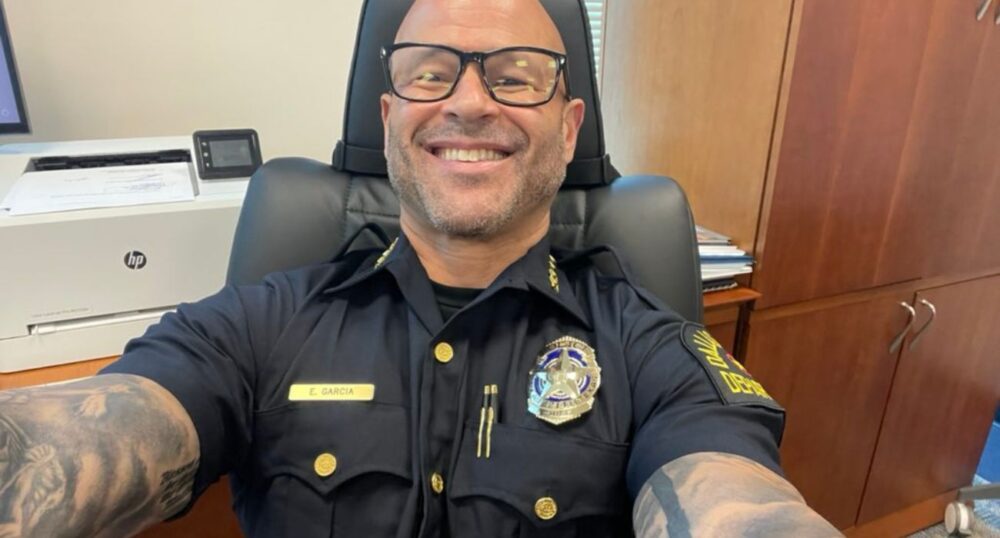The Dallas Police Department appears to have found another way to recruit and retain officers amid its ongoing staffing shortage: freedom of expression.
“When I got here over three and a half years ago, I think a lot of officers got excited because they thought I was going to change the tattoo policy because I have tattoos,” Chief Eddie Garcia told The Dallas Express. “But the way I was raised in law enforcement, being an officer for over 32 years, it’s just not what I was used to.”
Garcia has tattoos on his arms. Under a prior departmental policy, visible tattoos had to be completely covered while on duty. Face and neck tattoos were not and are still not permitted.
“We are the only large Texas city that prohibited tattoos, so we were an outlier in that area,” Garcia said. “Nothing we did was necessarily groundbreaking in any way. I guess the only groundbreaking thing is old-school cops like me have to evolve and listen to the associations and rank-and-file and the recruiting unit. I certainly did not want to come here and change a policy for selfish reasons.”
That’s why Garcia “pushed back” against a policy change — until now.
“My recruiting unit said it would increase morale,” he said. “We have to keep in mind that we have a younger generation. We have to keep in mind it’s not a stigma around it as long as it’s following the policy regarding tattoos. It doesn’t define us.”
According to a June 21 memo from Dominique Artis, the City’s chief of public safety, the policy on tattoos and personal grooming was revised as part of Interim City Manager Kimberly Tolbert’s “100-day Transition Playbook,” which includes six “primary focus areas.” One of them is recruitment and retention at DPD and Dallas Fire-Rescue.
DPD only fields around 3,000 officers, even though a prior City analysis advised that roughly 4,000 are needed to properly police the city and get police response times to reasonable levels.
Moreover, DPD’s budget is only $645 million this fiscal year, as the Dallas City Council opted to spend far less taxpayer money on policing than other high-crime municipalities, such as Chicago, New York City, and Los Angeles.
“For DFR, the Manual of Procedures 710, Personal Appearance and Uniform Standards, has been updated to include the limited allowance of visible tattoos. For DPD, General Orders 804.00, Personal Appearance, has been updated to allow groomed, natural beards and approved, visible body art,” the memo continues.
The policy update was made following “extensive research of industry best practices” and collaboration among DPD and DFR, City staff, and department employee associations.
“Both DFR and DPD believe these changes better reflect the current cultural and societal opinions of the practice of body modification,” according to the memo. “Additionally, they will have a positive impact on department morale and our recruiting and retention efforts. These are procedures also currently in place in other large police and fire departments within the State of Texas.”
Garcia posted a selfie on X that shows the tattoos on his arms.
“‘Please, let us have tattoos they asked …’ Well, I pushed back for over 3 1/2 yrs. They work tirelessly for our city … I gotta evolve a little … Won’t be everyday … but, here we go!” he wrote.
Garcia told DX this update on tattoos and facial hair does not mean other departmental policy changes are imminent.
“This is not to say that we’re going to evolve on everything but on this particular case, that is the realization that I came to, and the associations are happy,” he said. “The rank-and-file are happy. I hope it will increase morale and increase recruiting. Apart from stress from this job, it’s also a fun job.”
Garcia is president of the Major Cities Chiefs Association.
“I’m pretty recognizable when I’m off duty and out in public,” he said. “I’m good friends with former LA Police Chief Mike Moore and other chiefs who would jokingly give me a hard time about the policy. I’m the only chief probably in the country double-sleeved and not allowing tattoos. They would give me a hard time, mocking me for being such a staunch advocate for having tattoos covered.”
It was time for a fresh approach, Garcia said.
“Through the years, you’ve got to evolve, and it’s really that simple. We just don’t want to be an outlier. If other cities have done it and it helps morale and recruiting, we need to try it. We’re trying to be contemporary.”
The policy on facial hair is simple. Before Garcia arrived, officers were allowed to have it. He changed the policy to reflect it was no longer allowed.
“It has to be short length,” he said. “We don’t want beards getting out of control. I made it clear we can take away policies as quickly as we can give them. So, really, it’s on our personnel to ensure they police themselves.”
The Dallas Express reported earlier in June that for the current fiscal year, 785 applicants had been referred by civil service, that is, by City employees through the City’s pilot referral and retention program. Of those, 133 had entered the police academy.


